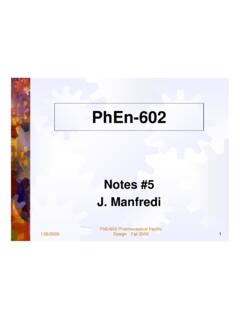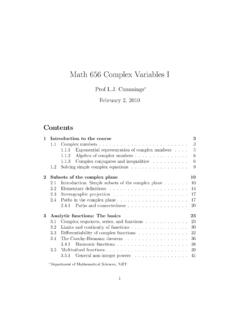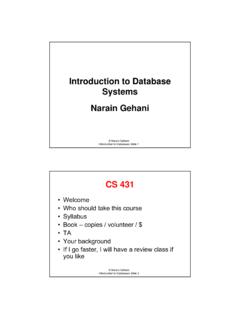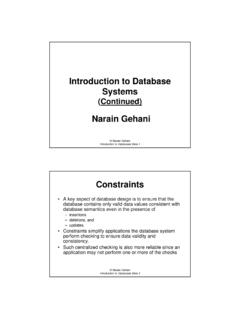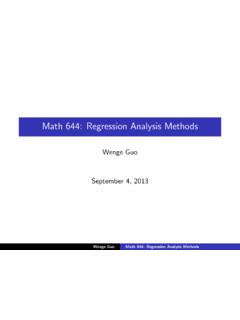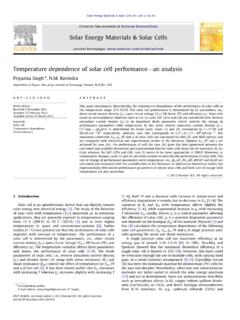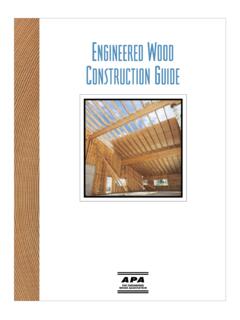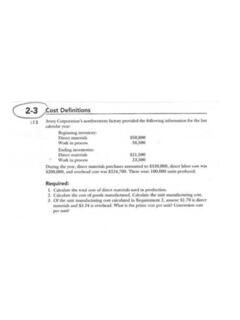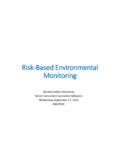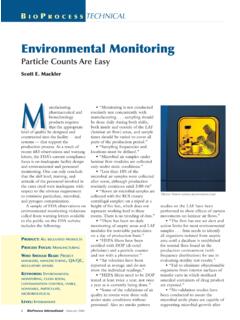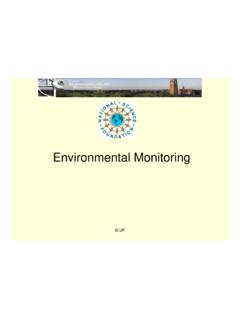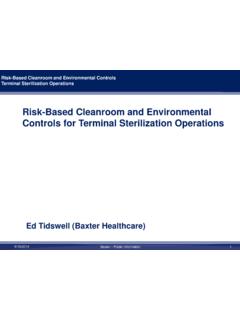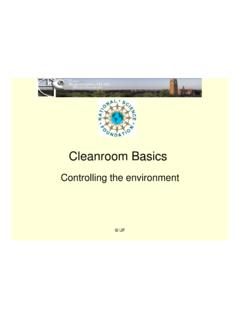Transcription of Clean Rooms – Environmental Monitoring
1 Pharmaceutical Facility Design Spring 20091 PhEn-602 Notes # 4 J. ManfrediPharmaceutical Facility Design Spring 20092 Clean Rooms and Controlled EnvironmentsBasic definitions Clean room :A room in which the concentration of airborne particles is controlled and contains one or more Clean zones Clean Zone:A defined space in which the concentration of airborne particles is controlled to meet a specified airborne particulate class. Pharmaceutical Facility Design Spring 20093 Clean Rooms and Controlled Environments Federal Standard 209E (FS-209E) provides Clean room Classes Rooms classified based on number of particles > micron per cubic foot Class descriptions still in use today. FS 209E is concerned about the following particle sizes, in , , , , Facility Design Spring 20094 Clean Rooms and Controlled Environments Types of Contaminants Viable Particulates Non-Viable ParticulatesPharmaceutical Facility Design Spring 20095 Controlled Environments -Types of Contaminants Non-viable Particulates Metal specks, fiber from clothing Obtained from: Equipment, people, tools Viable (micro-organisms) Bacteria Yeast, molds Obtained from: People, outside air, water, equipment, tools, excipients, active ingredientsPharmaceutical Facility Design Spring 20096 Clean Rooms and Controlled EnvironmentsSources of particulate generation Internal.
2 Personnel Normally the highest source of contamination Process Air conditioning system Introduction of raw materials Introduction of equipment and materials External Outside air Pharmaceutical Facility Design Spring 20097 Clean Rooms and Controlled EnvironmentsSome interesting facts: Visible indoor air particles constitute only about 10% of particles present in indoor air. It may be possible to see particles as small as 10 microns It may be possible to see particles as small as 10 microns under favorable conditions. The majority of harmful particles are 3 microns or less in size. Particles of 1 micron or less adhere to surfaces by molecular adhesion. Scrubbing is generally the only way to remove them. Larger particles tend to settle out of the atmosphere due to Facility Design Spring 20098 Clean Rooms and Controlled EnvironmentsSome more interesting facts: Smaller, "respirable" particles remain virtually suspended in the air until breathed in.
3 Approximately 98-99% of all particles by count are in the size range of 5 microns or less. These particles tend to remain in suspension or settle out so slowly. From: Facility Design Spring 20099 Clean Rooms and Controlled EnvironmentsCommon items and their respective particle sizes: MicronsEye of a needle 1,230 Human Hair40 300 Oil to to 20 Pollens10 to 1,000 Coal Dust1 to 100 Beach sand100 to 2,000 Mold to 20 Tobacco to 1 Typical Atmospheric to 30 Pharmaceutical Facility Design Spring 200910 Clean Rooms and Controlled Environments100 Microns25 MicronsOthercontaminantsHuman HairDustPharmaceutical Facility Design Spring 200911 Personnel Largest Source of Contamination People are huge sources of contamination -the biggest source of viable and non-viable contamination Each adult loses about 6 - 14 grams of dead skin material every day Each person loses a complete layer of skin about every four days - equivalent to 10,000,000 particles per day!
4 Ordinary walking movements emit about 10,000 particles per Facility Design Spring 200912 Personnel Largest Source of Contamination Particle Generation RateParticles/secondParticle 105 Carefully Walking in Good Clean room garments Walking in Clean room garments Walking in Normal ClothesPharmaceutical Facility Design Spring 200913 Clean Rooms and Controlled Environments Occupancy state of the cleanroom: As-Built: As constructed, with no equipment or personnel in room At-Rest: Equipment in room , but no personnel Operational: (also called In-Operation )Personnel and equipment in room , under normal operations Pharmaceutical Facility Design Spring 200914 Clean Rooms and Controlled EnvironmentsFDA Aseptic Guidelines 1987 Requires pharmaceutical companies to use the FS-209E classifications for aseptic manufacturing. Non-viable particle levels must meet the FS 209E classes.
5 Concerned only with the in-operation condition. Concerned only with particles greater than or equal to microns. Contains limits for viable particles also to be discussed : Pharmaceutical Facility Design Spring 200915 Clean Rooms and Controlled EnvironmentsFDA Aseptic Guidelines 1987 Controlled Area: A controlled area is one in which unsterilizeddrug product, in-process materials or containers/closures are acceptable air quality if it has a per-cubic-foot particle count of not more than 100,000 in a size range of micron and larger (Class 100,000) when measured in the vicinity of the exposed articles during periods of activity. Pharmaceutical Facility Design Spring 200916 Clean Rooms and Controlled EnvironmentsFDA Aseptic Guidelines 1987 Critical Area: A critical area is one in which the sterilized drug product, containers, and closures are exposedto Environmental air quality of Class 100 in a size range of micron or larger when measured no more than 1 ft away from work Pharmaceutical Facility Design Spring 200917 Clean Rooms and Controlled Environments FDA Aseptic guidelines:section 4, Buildings and Facilities: Clean area control parameters should be supported by microbiological and particle data obtained during qualification studies.
6 Initial cleanroom qualification includes, in part, an assessment of air quality under as-built, static conditions. It is important for area qualification and classification to place most emphasis on data generated under dynamic conditions ( , with personnel present, equipment in place, and operations ongoing). An adequate aseptic processing facility Monitoring program also will assess conformance with specified Clean area classifications under dynamic conditions on a routine basis .Pharmaceutical Facility Design Spring 200918 FDA Aseptic Guide Class of Clean room Supporting Clean Areas Supporting Clean areas can have various classifications and functions. Many support areas function as zones in which nonsterile components, formulated products, in-process materials, equipment, and container/closures are prepared, held, or transferred. These environments are soundly designed when they minimize the level of particle contaminants in the final product and control the microbiological content (bioburden) of articles and components that are subsequently Facility Design Spring 200919 FDA Aseptic Guide Class of Clean room Supporting Clean Areas The nature of the activities conducted in a supporting Clean area determines its recommends that the area immediately adjacent to the aseptic processing line meet, at a minimum, Class 10,000 (ISO 7) standards under dynamic conditions.
7 Manufacturers can also classify this area as Class 1,000 (ISO 6) or maintain the entire aseptic filling room at Class 100 (ISO 5). An area classified at a Class 100,000 (ISO 8) air cleanliness level is appropriate for less critical activities ( , equipment cleaning).Pharmaceutical Facility Design Spring 200920 Clean Rooms and Controlled EnvironmentsFDA Aseptic Guidelines as mentioned:Originally published in 1987 Revised - September 2004 Guidance for Industry Sterile Drug Products Produced by Aseptic Processing are Guidelines not regulations (21 CFR 210 and 211 are regulations/law). However, as far as manufacturers are concerned, they are asimportant as the law, since it represents FDA s current thinking IV: Buildings and Facilities*important guidelines re: aseptic facility design Pharmaceutical Facility Design Spring 200921 Clean Rooms and Controlled Environments Federal Standard 209E Cleanroom ClassesClass(English)Max.
8 # Particles/ft3 of a size m1110101001001,0001,00010,00010,000100,0 00100,000 Pharmaceutical Facility Design Spring 200922 Clean Rooms and Controlled EnvironmentsThe development of ISO standards: Before 2000 each country developed its own cleanroom standards US followed Federal Standard 209E Several European Countries assembled as part of CEN - Committee for European Normalization - to standardize cleanroom standards CEN standards were initiated Prior agreement between ISO and CEN ISO standards would take precedence Pharmaceutical Facility Design Spring 200923 Clean Rooms and Controlled EnvironmentsCleanroom Standards: FS 209E - The traditional cleanroom standard for all industries. Obsolete as of November 2001, replaced by ISO standards FS 209E still being used by Industry currently uses both 209E and ISO classifications in the design of today s cleanroom, but 209E will eventually fade-away Pharmaceutical Facility Design Spring 200924 Cancellation of FED-STD-209E The General Services Administration (GSA) released a Notice of Cancellation for FED-STD-209E, Airborne Particulate Cleanliness Classes in Cleanrooms and Clean Zones, on November 29, 2001.
9 (Please note that the IEST address changed after the issuance of the notice. The new address is 5005 Newport Drive, Suite 506, Rolling Meadows, IL 60008-3841.) The Notice of Cancellation is based on the recommendation by IEST Working Group CC100 that FED-STD-209E no longer be maintained. The IEST, assigned by the GSA as the Preparing Activity organization for FED-STD-209E, has recommended that International Standard ISO 14644, Cleanrooms and controlled environments-Part 1: Classification of air cleanliness, and Part 2: Specifications for testing and Monitoring to prove continued compliance with ISO 14644-1, supersede FED-STD-209E. ISO 14644-1 and 14644-2 are two parts of a multi-part group of ISO Standards developed by ISO Technical Committee 209 (ISO/TC 209). All ISO/TC 209 Standards may be ordered online through IEST. Click here to enter the IEST Publications Store. NOTICE OF CANCELLATION FED-STD-209 NOTICE 1 November 29, 2001 FEDERAL STANDARD AIRBORNE PARTICULATE CLEANLINESS CLASSES IN CLEANROOMS AND Clean ZONES Federal Standard 209E dated September 11, 1992 is hereby canceled and superseded by International Organization for Standardization (ISO) Standards.
10 International Standards for Cleanrooms and associated controlled environments, ISO 14644-1 Part 1: Classification of air cleanliness; and ISO 14644-2 Part 2: Specifications for testing and Monitoring to prove continued compliance with ISO 14644-1. Application for copies of ISO Standards 14644-1 Part 1, and 14644-2 Part 2; may be addressed to the Institute of Environmental Sciences and Technology (IEST), 940 East Northwest Highway, Mount Prospect, IL 60056-3444. Phone: 847-255-1561, Fax: 847-255-1699, Web site: , E-mail: Preparing Activity: GSA-FSSFSC 3694 Pharmaceutical Facility Design Spring 200925 Clean Rooms and Controlled Environments ISO Technical Committee 209 was formed (no relation to FS 209 which was to be superceded) Each country sent their delegates to the committee meetings First meeting in 1993 Scope:To develop a set of international standards which standardize equipment, facilities and operational methods for cleanrooms and associated controlled environments Pharmaceutical Facility Design Spring 200926 Clean Rooms and Controlled Environments Scope included defining operational limits, procedural limits and testing attributes to minimize micro-contamination.
